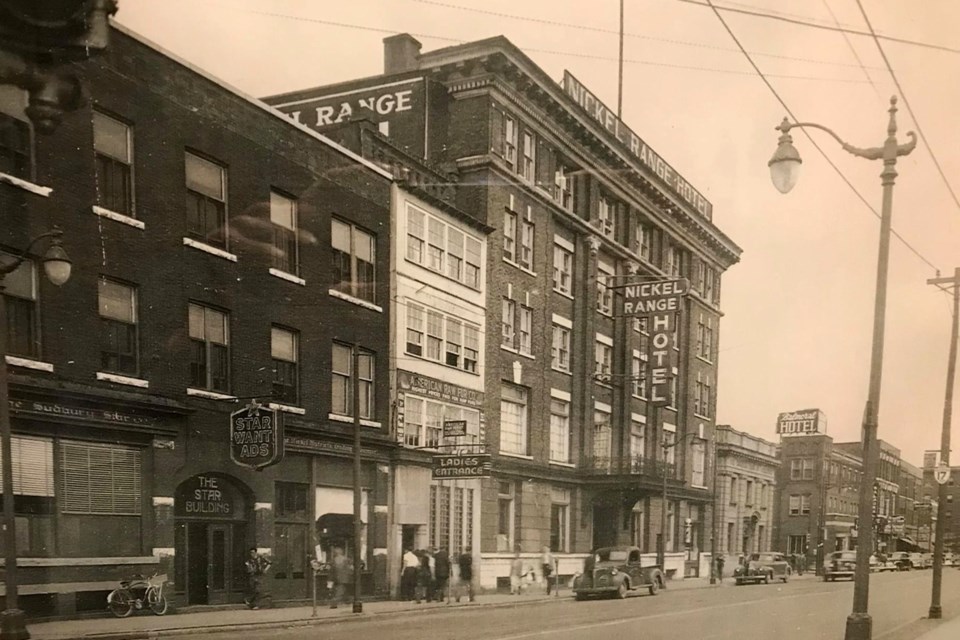The auctioneer’s gavel slammed down on the podium. “Sold! Your number, sir? Thank you.” And, with that, the last item from the 60-year-old Nickel Range Hotel had been purchased by a buyer looking to own a piece of Sudbury’s history.
Now you’re probably asking yourself, “What brought us to this point?” In this article we’re going to trace the final few months in the life of the Nickel Range Hotel. And, I’m sure more than a few readers will see certain similarities with recent city purchases in the downtown core.
The Nickel Range on Elm Street underwent many changes and even changed hands many times since it was first established as the White House in 1886. The original frame building was then the centre of town and became a place where a growing economy spread good times. When advancing technology forced renovations within the hotel industry, the Nickel Range brick building was constructed in 1915, replacing the White House.
The new name bestowed upon it was as Sudbury as one could ever imagine. After all, we were the Nickel Capital of the world (the original owner, D.M. Morin had found his riches through mining). The Nickel Range was the cornerstone for a growing and bustling downtown.
Her opening was meticulously described by the Sudbury Journal in 1915, which spoke of her “Italian Renaissance architecture”, "Caen stone cornices in the Doric treatment” and “dining room in the Ionic style” summing things up by stating that "the building is throughout a magnificent structure.” (Would you expect any less for a place that charges the enormous sums of $1.50 and $2.00 a day?)
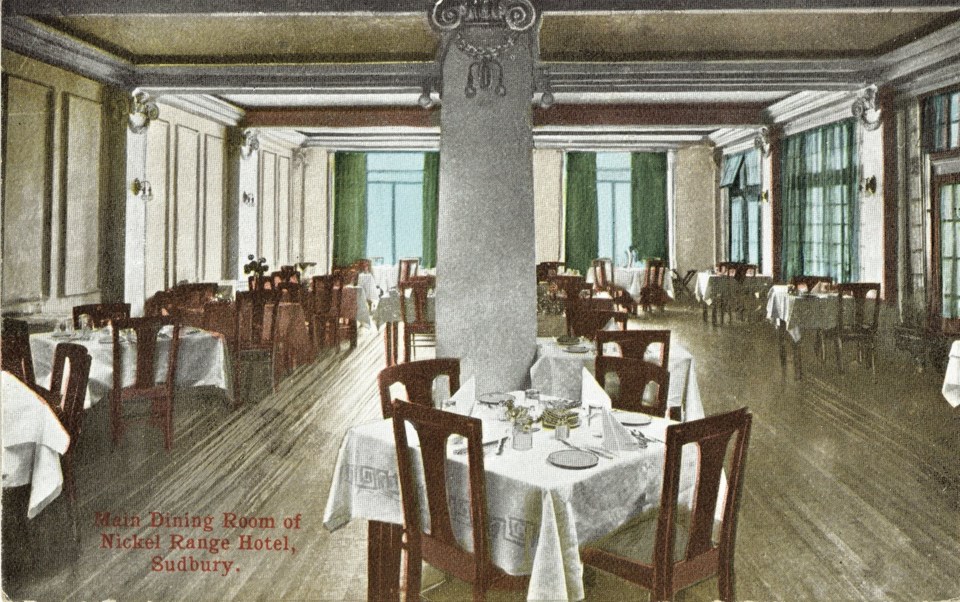
However, by the mid 1960s, newer and flashier hotels, including the nearby President Hotel, as well as the Ambassador and the Sorrento (built out in the suburbs of New Sudbury) were entering the scene to share the travellers’ dollars.
To combat this new competition, there were plans made to explore renovating the Nickel Range, which would have included a rooftop garden with dancing and dining facilities, but money worries and heavy debts ended that dream.
Ernest Hemingway, Lester B. Pearson, John Diefenbaker, King George VI and his Queen have all stayed at the Nickel Range (when the King and Queen visited in 1939, it is said that all of the bar glasses were enthusiastically smashed against the wall).
Unfortunately, that guest pedigree was not enough to continue enticing people to stay at a hotel that had seen better days.
In January 1975, the owners of the Nickel Range Hotel accepted a conditional offer from the city for the purchase of the building and adjacent property. While the total purchase price was $545,000, the city proposed that the cost due on closing of the deal would be $135,000 and $333,000 would be assumed by way of existing mortgages and the remaining $80,000 would be a write-off of municipal taxes (Between 1966 and 1975, the hotel owners tax arrears had jumped from $6,000 to $80,000).
City council had agreed to make the purchase, which would be conditional on approval by the Ontario Municipal Board on the method of financing.
The attempt to purchase was the result of a 1973 council resolution authorizing intensive negotiations to purchase property in the downtown area for future parking needs. As well as the hotel, a parking lot, a pool hall behind the hotel and a house at the corner of Beech St. and Frood Rd. were involved in the purchase.
At the beginning of February, the city’s Transportation Department Committee recommended a brief study in order to determine if the Nickel Range Hotel could be suitable for leasing if and when the city purchases it. However, Vic Kuula, the city’s property administrator who would be conducting the study, told the committee that from a cursory look at the structure, "with the state it's in now, I think it would have to close down."
Christopher Kennedy, who was renting the rooms in the hotel, requested to know council's intentions regarding the short-term future of the building. He indicated at the time that if it could remain for three years he could put $100,000 work into the aging structure, while recovering the money in that same period. Kennedy indicated that activity in the building was gradually decreasing. He cited the closing of the dining room and a lounge, the imminent closing of the coffee shop and the hotel laying off 19 employees.
However, Vic Kuula said from his preliminary examination, he could only recommend leasing out the building if the lessee "takes responsibility for the whole thing.” He cited falling walls, faulty piping and a furnace which was seriously deteriorating. A barber in the hotel, Eugene Byers, was quoted at the time that if “a beer bottle was thrown through a window, the thrower said the building will come down in three months anyways…They're kicking the walls in and everything else."
Future mayor, Jim Gordon, then an alderman, reminded his colleagues that so far the city only had in an offer to purchase. If anything other than parking was planned for the property in the near future, some councillors might change their minds about buying the place.
The committee, he said, would be misleading people at this time about the future of the building by discussing any alternative uses. "We don't own it so stay out of it. We're asking for trouble," said Gordon.
Another future mayor, then city engineer Peter Wong said the city has to face up to what it will do with the building if it is acquired.
"Is it feasible to run it? Are we going to lose money," Wong asked at the time. Noting the many inquiries received from exiting tenants, Wong said, "We can tell the people the same thing as Alderman Gordon (said) but it doesn't make them too happy."
Alderman Dick DeStefano estimated at the time that if the city followed through with its plans to turn it into a parking lot, they would be looking at revenues of $30,000 per year.
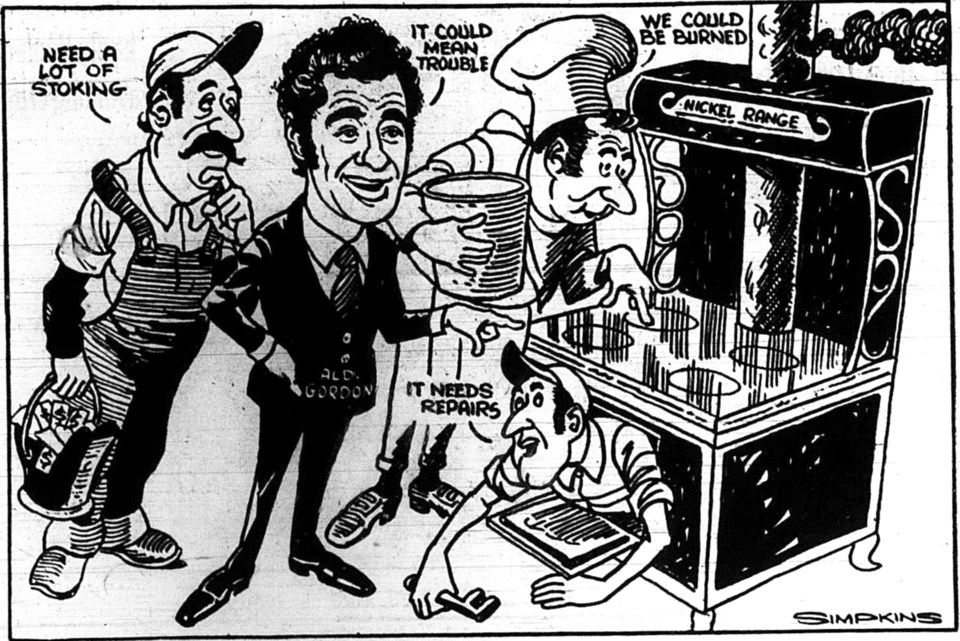
City solicitor Dennis Perlin told the committee, "It is extremely important to have some plan of action as to what will happen" to the building, adding he didn't believe the OMB would say it had to be used for parking purposes immediately upon takeover. But continued delay in implementing the land for parking would make it appear that the city acted in bad faith, he said.
At the beginning of March, the Ontario Municipal Board announced that it had approved the purchase of the Nickel Range property by the city, paving the way for its finalization by council.
Unfortunately for this part of Sudbury’s real estate heritage, at the beginning of April 1975, with the OMB approval in their pocket, city council’s transportation committee recommended that the Nickel Range Hotel should be demolished as early as possible in that year's construction season.
Vic Kuula, the city’s property administrator, reported that it would cost about $40,000 to keep the building in shape for occupancy, along with an additional $8,000 monthly in upkeep. The previous March, someone had even tried to set fire to the hotel resulting in $400 in damages to flooring and draperies. Then, not long after Kuula tabled his report, Ontario Hydro's chief inspector hit the city with more potential costs, indicating that the building would also require major electrical renovations.
With Mayor Joe Fabbro casting the deciding vote, city council at their meeting in the beginning of May 1975, decided that it would offer to sell their recently acquired Nickel Range Hotel property. The issue was placed before council by Alderman Doug Frith who was quoted at the time that a sale would "alleviate a hell of a lot of pressure on our current budget.” Frith also stated that since the fire hall on Elgin Street (the current 12 Elgin St.) was relocating to its current location at Van Horne and Shaughnessy Streets, that property and the municipally owned parking below will be satisfactory for the city’s needs on municipal property.
“Our parking requirements will be fulfilled on city land,” he said, “and the hotel site will become superfluous.”
However, council remained steadfast in going ahead with a $350,000 demolition in the near future, as some councillors were not very optimistic about a quick sale. Former owner Jean-Paul Rouleau said at the time (with grim satisfaction) that “they’re going to have a hell of a time pulling her down … There’s a nail to every square inch. She’s built like a fortress!”
Alderman Dick DeStefano put up a fight against the sale as he saw the city controlling the land for a commercial node. He believed the property provided the city with a negotiating tool to control development in the downtown core. His colleague Doug Frith argued that a priority location in terms of a viable, downtown core was to the south of Elm and not on the Nickel Range area.
The city paid $540,000 for the Nickel Range property but DeStefano figured that the selling price, if the property was retained, could double in two years. Frith countered by saying that he knew of other property purchases in the downtown which he was sure were not doubling. The Sudbury New Democratic Riding Association condemned the city's handling of the hotel transaction at the time, saying, "The city has no business being involved with real estate transactions unless the property is definitely required for public use." The council will "stand doubly condemned" if there is a loss to taxpayers from the sale, the association said. "There are still, too many vital items required by the city’s residents, for council to be dealing in speculative ventures such as this," they continued.
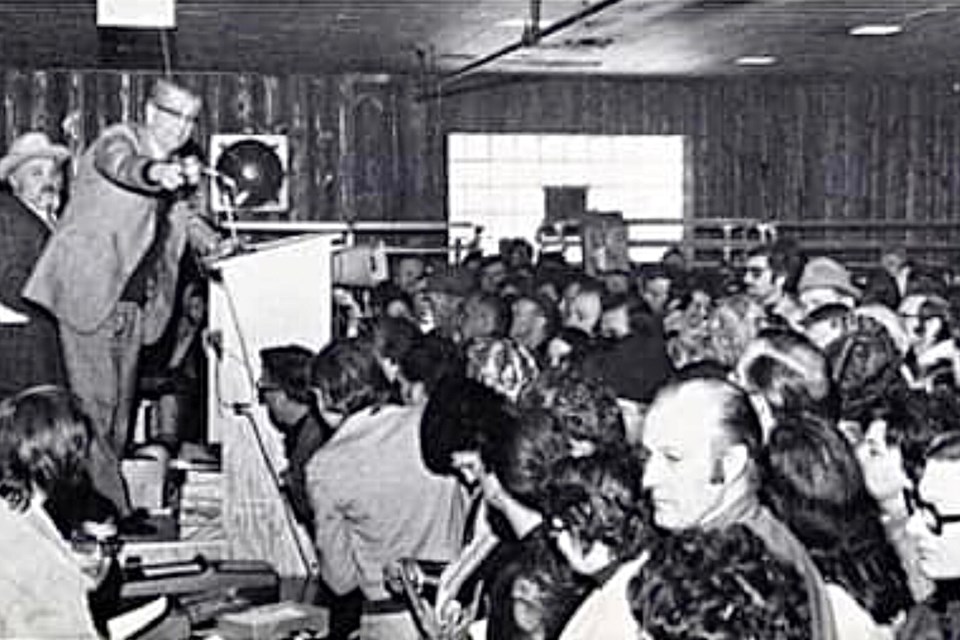
The hotel was all but closed down after the city took possession, with only a barber shop being operated (which was vacated by mid-April). The contents of the building were recommended to be sold at public auction, leading Mayor Fabbro to wonder just what there was left to sell.
He said he toured the building after the sale was completed and reported to his colleagues on council that "there’s nothing there." When a suggestion was made that a depreciated value of the contents might have been used, Mayor Fabbro commented, "There's nothing left over there to depreciate." An inventory made of the contents, amounted to a monetary estimation of $15,000 leading Alderman Dick DeStefano to question the low value in a half-million dollar building. "What were they running, a hot dog stand?” he exclaimed.
At auction time, in late April 1975, long tables could be found sagging wearily under the burden of aging cash registers, neglected linens and a veritable hodgepodge of matched and mismatched crockery. With barely room for those in attendance to breathe, the auction at Sudbury's Nickel Range Hotel got under way. Sudburians came out in full force, filling the sadly neglected halls for one final time with a jumble of voices and laughter.
For some in attendance, it was a rather morose affair, remembering parents and grandparents who had frequented the Nickel Range during its heyday for every significant milestone in their lives. Also present at the auction were eager bargain hunters finding precious stained-glass windows and cutlery at rock-bottom prices. However, for the most part, Sudburians had come out to claim a souvenir, a memento of days long gone.
A month after the auction of goods at the Nickel Range, Alderman Jim Gordon told council he was "displeased" with the way merchandise was sold at the auction. “Many people were very angry,” said Gordon. “They kept changing the rules of the game as they were auctioning.” Gordon also charged that the public wasn’t given an opportunity to view the merchandise prior to it going before the auctioneer’s hammer.
Alderman Richard Dow was interviewed at the time and said that he spoke to several auctioneers goers “and they said that people who were bidding were out of their cotton-picking minds.” Alderman Maurice Lamoureux (who also held the mayoralty in the early 1980s) said he spoke to one woman who attended many auctions, but “not one run this badly.”
City property manager Vic Kuula said at the time that the auction was well staffed by city staff and he had received no complaints “other than paying $15 for a dirty old mattress.” He said that articles were sold both individually and in bulk, but that either way, the city did not lose money on them.
By the middle of 1975, the entirety of the west wing of the Nickel Range had been demolished with the rest of the building expected to disappear over following couple of months. Site superintendent Frank Santaguida said that the building required dismantling “brick by brick”, because it was too dangerous to use a wrecker. As he explained it, using a wrecker's ball would endanger the public as well as nearby buildings.
A 22-man crew was charged with salvaging doors, toilet fixtures and wood which the public could then buy on site at bargain prices. “Good bricks” were sold for three cents each. The remaining rubble would then be sent to the city dump.
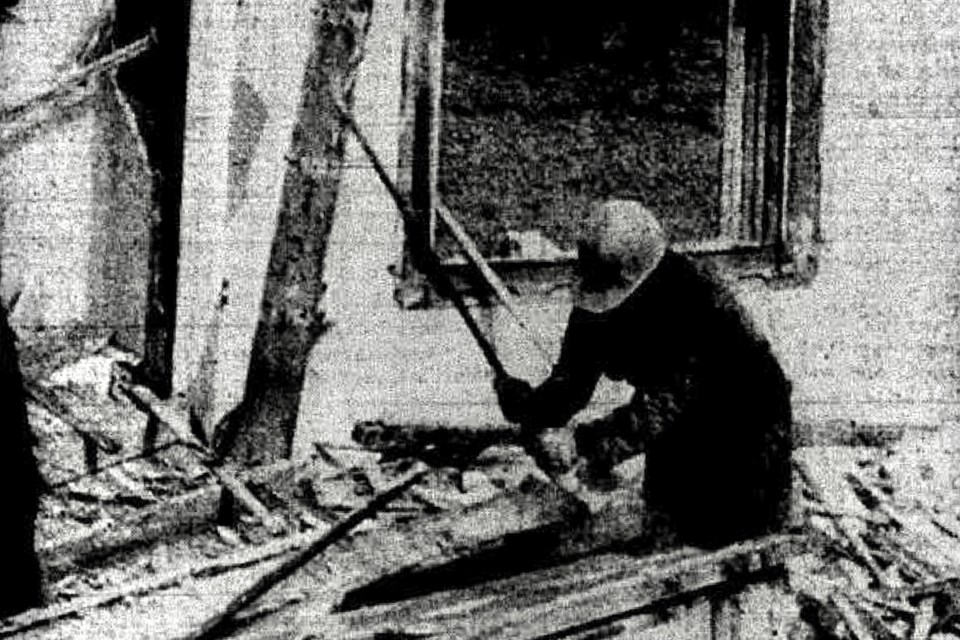
If a person were to enter the inside of the building at this time it looked as though it's been hit by a whirlwind, with the floors covered in debris, clothing left behind by former guests, old furniture that never made it to auction and even bookkeeping documents.
Santaguida joked that unfortunately no skeletons or vast fortunes had been found hidden within its 60-year-old walls. As most residents had vacated around the holiday season, Christmas decorations still hung in some of the rooms and hallways of the building. Santaguida said at the time, that when workmen started clearing the basement he hoped to find some antique items, such as pictures. The remnants of six decades of history, now just a pile of lost memories.
Well dear readers, 50 years ago the sun set on a beloved part of our downtown. A hotel once described as "the best hotel between Winnipeg and Toronto" which held a place in the hearts of Sudburians right until the (very) bitter end. Now, to borrow the title of the first novel of one of its famous guests, let’s see that “The Sun Also Rises” on your memories of visiting the grand old dame of the Downtown. Share your memories and/or photos by emailing them to Jason Marcon at [email protected] or the editor at [email protected].
Jason Marcon is a writer and history enthusiast in Greater Sudbury. He runs the Coniston Historical Group and the Sudbury Then and Now Facebook page. Memory Lane is made possible by our Community Leaders Program.
